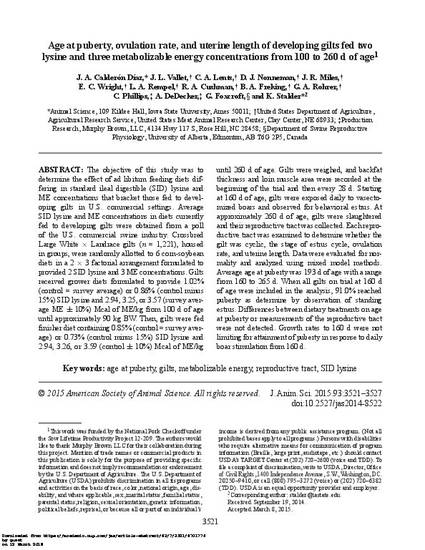
The objective of this study was to determine the effect of ad libitum feeding diets differing in standard ileal digestible (SID) lysine and ME concentrations that bracket those fed to developing gilts in U.S. commercial settings. Average SID lysine and ME concentrations in diets currently fed to developing gilts were obtained from a poll of the U.S. commercial swine industry. Crossbred Large White × Landrace gilts (n = 1,221), housed in groups, were randomly allotted to 6 corn-soybean diets in a 2 × 3 factorial arrangement formulated to provided 2 SID lysine and 3 ME concentrations. Gilts received grower diets formulated to provide 1.02% (control = survey average) or 0.86% (control minus 15%) SID lysine and 2.94, 3.25, or 3.57 (survey average ME ± 10%) Mcal of ME/kg from 100 d of age until approximately 90 kg BW. Then, gilts were fed finisher diet containing 0.85% (control = survey average) or 0.73% (control minus 15%) SID lysine and 2.94, 3.26, or 3.59 (control ± 10%) Mcal of ME/kg until 260 d of age. Gilts were weighed, and backfat thickness and loin muscle area were recorded at the beginning of the trial and then every 28 d. Starting at 160 d of age, gilts were exposed daily to vasectomized boars and observed for behavioral estrus. At approximately 260 d of age, gilts were slaughtered and their reproductive tract was collected. Each reproductive tract was examined to determine whether the gilt was cyclic, the stage of estrus cycle, ovulation rate, and uterine length. Data were evaluated for normality and analyzed using mixed model methods. Average age at puberty was 193 d of age with a range from 160 to 265 d. When all gilts on trial at 160 d of age were included in the analysis, 91.0% reached puberty as determine by observation of standing estrus. Differences between dietary treatments on age at puberty or measurements of the reproductive tract were not detected. Growth rates to 160 d were not limiting for attainment of puberty in response to daily boar stimulation from 160 d.
Available at: http://works.bepress.com/kenneth_stalder/183/

This article is published as Calderón Díaz, J. A., J. L. Vallet, C. A. Lents, D. J. Nonneman, J. R. Miles, E. C. Wright, L. A. Rempel et al. "Age at puberty, ovulation rate, and uterine length of developing gilts fed two lysine and three metabolizable energy concentrations from 100 to 260 d of age." Journal of animal science 93, no. 7 (2015): 3521-3527. doi: 10.2527/jas.2014-8522.